AcomData E5 320GB External Desktop Storage: Slap on another
by Purav Sanghani on August 27, 2005 12:48 PM EST- Posted in
- Storage
The Software
What makes the E5 stand out from those older external storage devices? The main feature is the PushButton backup that allows us to back up predefined lists of files or even an entire volume at the press of a single button. AcomData includes with the E5 a CD containing USB 2.0 drivers for the older Windows 98/SE/ME operating systems, the PushButton Backup software, and Retrospect Express, which allows scheduling and scripting multiple types of backups. Retrospect Express is a piece of software by one of the leading storage device companies, EMC, so we expect and can probably assume it to be reliable.Take a look at some of the screens to get a better idea of what the software is capable of…

Backup Options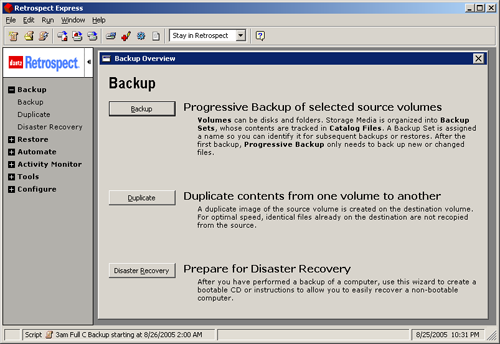
Click to enlarge.
Restore Options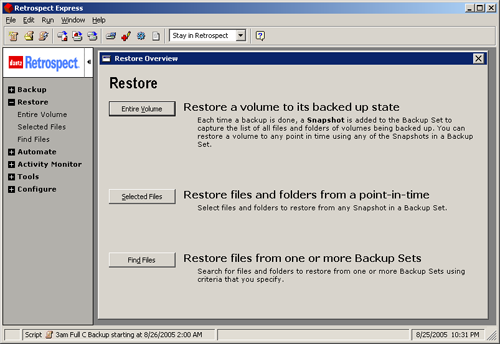
Click to enlarge.
Activity Monitor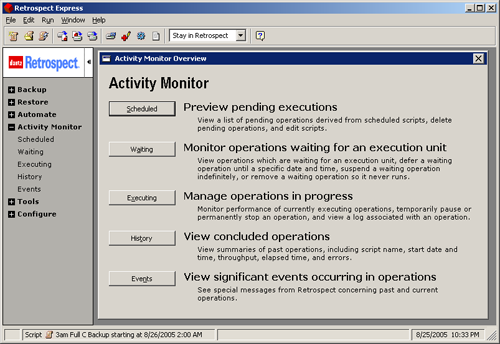
Click to enlarge.
Configuration
Click to enlarge.


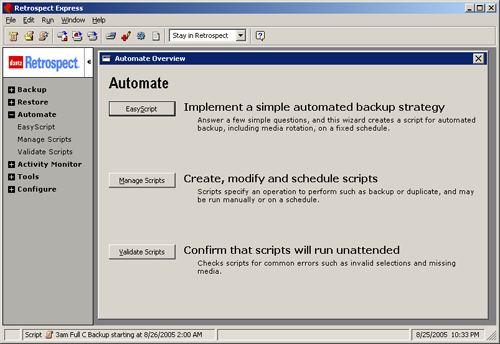
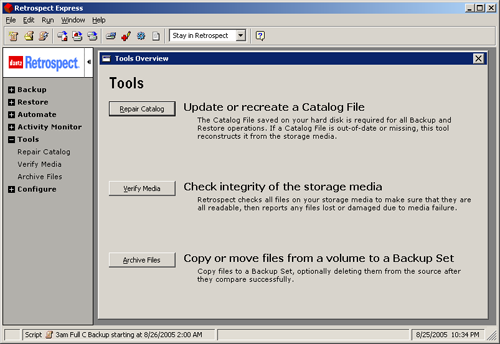








19 Comments
View All Comments
pcmatt1024 - Sunday, August 28, 2005 - link
according to the test bed setup on p. 4, the test system is running ddr2 on an amd system. what gives?deathwalker - Sunday, August 28, 2005 - link
This device is in CompUsa's weekly sale add this morning......$199 after rebate.Ripvanwinkle - Sunday, August 28, 2005 - link
"And as for thermal readings, the E5's aluminum construction did not heat up a single bit"Of course it does not heat up but what is the HD's temp?
I have used an SATA Bytecc box for 7 months with a 3' sata cable, WD200G HD running as my XP64 play OS and for regular backups.
I see speedfan temps reach 52C.
The new small externals need better cooling, and if buying get a larg one.
kennyG - Sunday, August 28, 2005 - link
I bought about 4 weeks ago 2/250 ext Acomdata SATA drive's which come with the sata card ..I get "Great" performance..and you can raid them up for even faster speed..I bought them at CompUSA..$200 each..if you want faster than USB/Firewire try one of these..great item..ken..
V00D00 - Saturday, August 27, 2005 - link
What gives? You guys should have got a few more external drives to test this one against. I must say I am dissapointed that you guys didn't even compare this with a LaCie or something. Now that would be a good review. A BUNCH of external drives.wilburpan - Saturday, August 27, 2005 - link
I was initailly excited when I saw "real world tests" in this article. But the one test I would have liked to see was missing.If one of the goals of an external hard drive is to provide painless one button backup, then a good "real world test" would be to measure how long it takes to completely back up a hard drive with, say, 100GB of data using this system.
I was a little suprised to see how little difference there was between FireWire 400 and USB 2.0 transfer rates.
Dranzerk - Saturday, August 27, 2005 - link
You can buy a aluminum enclosure for a harddrive yourself. Most of the price preminum for this is the software.I got a 3.5 enclosure aluminum and firewire cable, threw in a 60gig drive, hooked to matching shuttle PC, works like a charm. Less than $100. Most of these devices only have certain place though, backup mainly. But your not going to store video on it with terrible transfer rates..:P
psychobriggsy - Saturday, August 27, 2005 - link
My external Firewire drive gets at least 30MB/s reads. It uses an Agere controller. I've heard the best Firewire IDE controllers are made by Oxford however. Apparently there is one controller that is really dire for Firewire, but it is the cheapest combo-chipset, and you've got to watch out for it. I personally don't care, I'm not using it for intensive purposes, the capacity is more important than the speed.CrystalBay - Saturday, August 27, 2005 - link
Who actually makes the HDD ? sorry , no I'm not.:)nullpointerus - Saturday, August 27, 2005 - link
I'd like to see a new perspective on computers and drives. I'm wondering what could be done if computers were reworked for modularity. We would basically have a CPU-in-a-box with memory, CPU, and mobo inside a tiny enclosure similar to the Mac mini.The back of the box would house one _very_ high-speed unpowered bus connector (PCIe-level stuff - decent for hi-speed RAID, 3D, etc.) and two or three moderate-speed unpowered connectors (S-ATA/SCSI-level - decent for single drives).
On the left side of this CPU-in-a-box, we would find a bunch of low-speed powered connectors (USB-2.0-level - decent for wireless NICs, sound, mice, etc.). On the right side of the box would be ports for the integrated NIC, AC'97 sound jacks, and possibly PS/2 legacy ports.
All external devices coming through the high-speed and moderate-speed connectors would be powered by also connecting them to the external power supply. The PSU would be in its own external case with a bunch of standard power connectors (like the modular PSUs, but with smaller connectors) all on the top. Also on top would be a tiny LED indicating voltage draw, load, etc. and a warning light. All power cables would be the same, with a common maximum power rating and a very low-speed data channel to communicate basic power requirements and status notifications. The PSU would have a standard cable for household power jacks.
Everything would be plug 'n play, so that you could remove your hard drive and GPU to play games on another computer, or swap components very easily. The CPU-in-a-box would act like a giant heatsink unto itself, possibly with fins, two large fans on top and bottom, and a finger-saving grill enclosure. Most people would just pick up a new box to upgrade their system. Enthusiast boxes could in theory be designed with a single thumbscrew for easy access to CPU, mobo, and RAM.
For those that would prefer not to have a mess sitting on their desks, components' layouts could be standardized somewhat, with a clip on one side, and on the bottom (which may not be centered) as well as a thumbscrew on the front. The CPU and PSU cases would be mounted in the rear. The traditional-looking tower case would itself be just a chunk of metal with some fans, one of those universal power cables, and holes for ports and drive bays, so it could function similarly to today's cases.